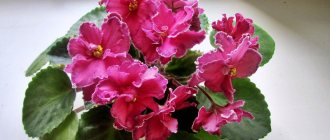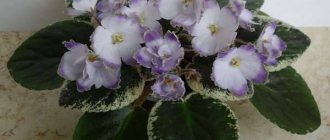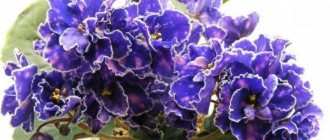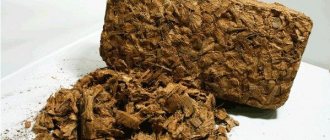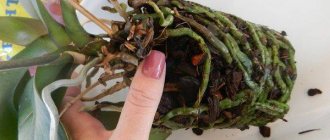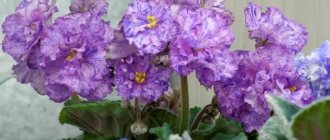In this article you will find a description of all varieties of Alen (Alina Volskaya) violets.
Breeding new plant varieties is painstaking work, it takes a lot of time and energy. However, true connoisseurs of Saintpaulia spare no effort to create unique new varieties. Alina Volskaya has been making Saintpaulias for many years. This hobby grew into something more. In these incredible flowers she finds inspiration and strength for the enormous selection work she devotes time to every day. Photos and descriptions of violets by A. Volskaya are presented below.
Description and photo of industrial varieties by Alina Volskaya
Lovers of indoor plants have long been familiar with the unique varieties of Saintpaulia Alain. They were bred by a breeder from Lvov. Among the most popular varieties of Saintpaulia by A. Volskaya are the following: Samanta, Zemfira, Proud Giant, Laetitia, Barcelona and others. Before each name the prefix “Alen” is indicated, that is, Alina.
Alain-Samantha
Violet petals are double and densely double. The flowers are large. The color is unusual - snow-white in the middle, crimson closer to the edges of each petal. The socket is of a standard shape, small in size. The leaves have small teeth along the edges and are round in shape. Color – bright, green. It is considered a new variety, since it was bred by a breeder in 2018.
Allen-Barcelona
The flowers of the plant are unique. Densely double, in appearance they resemble a rosebud. The color is soft pink with green edges. Before the flower fully opens, the underside of the petals on the bud is a delicate light green shade. The rosette is ordinary, the leaves are medium-sized and greenish in color. The variety often turns into a sport, but the color is preserved, only the fullness of the petals decreases. Caring for Saintpaulia is traditional.
Alain the Proud Giant
The variety is recognizable by its large inflorescences of rich wine color. Shows abundant flowering. Peduncles are elongated and dense. The rosette is voluminous, the leaves are oblong and medium in size. A young plant has slightly longer petioles than usual; the leaves of an adult violet are compact. The sport variety is also attractive: large double flowers of lilac color, with a white border along the edge.
Important! Owners need to keep in mind that at elevated room temperatures, the whitish color of the petals of this variety disappears. In a cool room, on the contrary, the petals become predominantly white.
Alen-Zemfira
Large inflorescences are double and densely double, of a dark beet color. The rosette is voluminous and develops quickly. At a young age, the plant has elongated petioles, then the violet becomes more compact. There is no space between the leaves. The variety was first introduced in 2015.
Alain-Laetitia
Terry inflorescences of medium size, soft lilac hue. A rosette with a traditional shape, bright green foliage with wavy edges. Often cuttings and peduncles grow too long. To prevent this, it is necessary to provide the violet with additional lighting in winter. Flowering is abundant. The sport of this variety has slightly smaller flowers and pink petals. At the same time, flowering lasts longer than that of varietal specimens.
Alen-117
Violet produces large semi-double flowers. The petals are pink with purple specks. Along the edges there is a thin green border. The rosette is ordinary, the leaves are rounded, and there is a slight wave along the edges. Increased room temperature makes the color of the petals somewhat paler, and the border also changes color. The variety tends to become a sport, so it is recommended to propagate violets using leaves and cuttings.
Alen-Crimson Rivers
The variety was presented at an exhibition in Kyiv in 2016. The flowers are simple, star-shaped, rich cherry color. The edges of the petals have a slight wave. The foliage is light green, round in shape, and has a neat rosette. The inflorescences form a cap with medium-sized buds. Maintenance and care are traditional.
Attention! One of the secrets of caring for Saintpaulias is a proper watering regime. There are several methods of watering. Watering from above along the edge of the pot is suitable for adult specimens. Watering “into the tray” is often used for children. Wick watering is used exclusively for adult plants. This type of watering is especially common in the summer.
Alen-Cloudless sky
The variety produces large flowers (9 cm). The structure is star-shaped, simple. Color – sky blue with a white center. Up to 5 buds are formed on the peduncle. Flowering is long and abundant. Rosette up to 20 cm, neat. The leaves are slightly pointed.
Alen-Viking
The dark blue flowers resemble discs. The edges of the petals are very wavy. The bouquets are not very large, but look impressive against the backdrop of bright green foliage. The peduncles are shortened, so Saintpaulia should have enough daylight. The variety is characterized by long flowering.
Alen-Commander
The inflorescences of this variety are simple or semi-double. The color is sky blue, with a light green edging along the edges of the petals. When the room temperature is low, it becomes brighter. The peculiarity of the variety is that the buds do not open completely. Flowering is long lasting. Large rosette, bright green leaves with small notches along the edges. Sport produces flowers of a more saturated shade.
Alain-Matilde
The petals of this violet are raspberry-colored and edged with bronze. The socket is standard, sloppy. The leaves are quilted, scalloped, and on the underside the surface has a reddish tint. Sport changes the color of the flower - the petals become lighter.
Important! In their natural environment, Saintpaulias live in humid areas. If the room is too dry, it is recommended to increase the humidity level to 60% or higher.
Allen-Cloud Atlas
The petals of the variety are pale blue in color, but the upper ones are slightly brighter. The flowers are double or semi-double, up to 6 cm in size. The peduncles are short, with 4 buds formed on each of them. The rosette is traditional, plates of sheets of rich green color, round in shape. No sports data available.
Alain-Silva
The variety produces small terry roses of pearlescent color. On the reverse side, the surface of the petals has a greenish tint. The peduncle is medium in size, each produces up to 7 buds. The leaves are medium-sized, light green in color with a wavy edge. There is no information about sports.
Alain Sombrero
A unique violet with dark purple flowers with ruffled edges. The outlet is small and neat. The leaf blades are round and green.
Description of varieties and their photos
Specialist D.Ness
Ness orange pekoe
“Orange tea of the highest grade” is how the name of this unusually beautiful plant is translated. Yes, not simple, but supplied to the court of the royal couple of the Netherlands since 1815!
Breeder D. Ness left behind a wonderful green legacy, including this fragile Senepoly with a perfectly symmetrical rosette and shiny carved leaves.
This variety is unpretentious, propagates well from leaf cuttings, and leaves numerous offspring. Its rich, almost orange color is achieved through proper feeding and good light.
Shades vary from lush coral to coral fawn , and the petals can be different even on the same rosette. Preferably natural. But this violet does not tolerate heat well - its variegated foliage can completely disappear at elevated temperatures.
Therefore, before growing, the gardener should think about whether he can create suitable conditions for this delicate beauty?
K. Stork
"Emergency"
Despite the somewhat “lobed” nature of the rosette, this is one of the most popular varieties among flower growers. And how can you not fall in love with these blood-red flowers with a clearly defined white border! This flower does not change its color even in extreme heat, which makes it stand out from other species.
The petioles are long, the leaves are dark green, slightly arched. The peduncle grows 4-5 buds, but it is not possible to grow a bouquet due to the peculiar growth of the stems - they are drooping, long and grow in different directions.
The southern balcony is most suitable for growing - it is there that the plant becomes noticeably more powerful. This variety is easy to care for. It blooms quickly and luxuriantly, is resistant to unfavorable environmental conditions, and also easily forgives minor maintenance flaws. The only thing that is strictly prohibited is wick watering.
Quilting bee
Curly – that’s how they affectionately call her on the forums. These densely double white and lilac stars, small and graceful, can present their owner with more than one surprise during flowering.
Depending on the ambient temperature, they can be darker or lighter, with or without a noticeable light green border around the edge. Forms an amazingly beautiful foam bouquet.
The leaves are quilted, shiny, wavy, looking in different directions. The rosette is loose. It produces few flower stalks - 1-2, rarely 3. It opens slowly, but it blooms for 2-3 months, to the delight of the collector.
He is greedy for children - he produces only a couple. It does not require care, but without systematic watering it quickly dies.
A. Kuznetsov
"SK Apple Garden"
It is noticeably different from its counterparts both in the shape of the leaves and the color of the buds. The rosette is 9-12 cm long, neat. The leaves are pointed at the tips, light green on the outside and silvery on the inside.
The buds are semi-double, white, with pinkish tips of the petals. It blooms profusely, forms a lush, cute white-pink cap that does not fade until the very end.
The peduncles are strong, stable, and hold 5-7 flowers. The bouquet does not fall off for 1.5-2 months, the old ones are replaced by the newly blossomed ones. By placing the pot in a cool room, the process can be prolonged.
Peduncles are formed 15.2 months after the previous flowering. Planted children take root quickly and produce flowers in 4-5 months.
When using wick watering, you should never overfeed the plant, otherwise the leaves will begin to darken and the flowers will “float.” At high temperatures in the room, the effect will be the same, and a crimson border will be added to the edges of the petals.
Flowering has to be interrupted by force to give the variety a rest. June is best for this. The plant is replanted and begins to gain strength again. Withstands re-rooting well.
B. Kostsevyat
"Valentina Tereshkova"
A simple-looking Saintpaulia with a neat little rosette. The flowers have a boiling white center and lilac tints on the edges and in the center of the petals.
Leaves are 3-4 cm long, flowers are 5-5.5 cm long. With age, the rosette grows up to 16 cm, and flowering becomes more luxuriant. This is a real hard worker - subsequent flowering occurs without a break.
Breeder G. Lazarenko
"The Rustle of Waves"
The violet with such a bewitching name has magnificent flowers: large, double, sky blue with a white border on the wavy edges of the petals. The leaves are hard, corrugated, and break easily. The rosette is loose and sloppy.
The flower stalks are weak, long, produce 4-5 buds, but cannot withstand their weight and fall over. The color is good, I form a thick head for the first time.
Gives a lot of children, is not capricious in caring for him. It can grow both on the windowsill and in the back of the room. It is not inclined to lift the leaves upward, but during rooting it needs special attention: excess moisture is destructive.
D. Denisenko
"DN Young French Girl"
The variety has purple flowers - bright and large. Even in hot conditions they retain a white (in some cases light green) border on the petals. It produces 5-6 buds, blooms for a long time and does not lose the richness of its shades.
The foliage is variegated, the leaves are wide, smooth, soft. The edges are openwork, with numerous white inclusions, merging in some places into wide spots.
"DN Rozhev convalia"
Every time you look at this pink bell, you involuntarily think - how will it ring now? The rosette is neat and forms quickly. The leaves are dark green, dense, hard. The edges are wavy, curved outward.
The petioles are long, dark brown, the edges of the petals are dark scarlet. Another hard worker: flower growers praise its long and abundant flowering. Propagates well by leaf, requires a lot of light and coolness.
I. Low-muscled
"Wedding Bells"
Pale pink flowers look very impressive against the background of dark foliage. Thin but strong peduncles stretch from a neat rosette.
It produces a lot of buds - 6-7, the bouquet lasts a long time. Despite its fragile appearance, the flower is very tenacious and will tolerate almost all flaws from the owner’s inattention.
N. Kozak
"Feeling of Holiday"
This Saintpaulia really gives a feeling of celebration and joy with just its appearance. And a variegated rosette, and large lush flowers of bright fuchsia color.
The leaves are medium-sized, serrated, with a thick white border and patches across the entire width. The petals are fringed, airy, and spread well.
Peduncles are straight and strong. The bouquet consists of 6-8 flowers. The variety is unpretentious and tolerant of temperature changes.
O. Aksenkina
"Deo marzipan"
If you want to bite a flower, it means it is the “Deo marzipan” variety. Only he has such delicious beige-pink flowers, reminiscent of marzipan roses. They grow in clusters, abundantly on the peduncle.
The stem itself is weak, causing the flowers to creep along the foliage. The rest period between flowering is short. The leaves are emerald green, pointed, and curve downwards. They grow in different directions.
The variety can grow in any conditions: both in the shade and in the sun.
O. Kosobkova
"Watch"
Hidden in the light green foliage are large milky-white stars with a garnet border around the edges and a pink coating on the petals. The petioles are thin but strong.
A very unpretentious variety that every beginner can grow.
R. Sorano
"Sassy Sister"
The buds are bronze in color, but the small opened flowers are striking with their bright pink color and green fringe along the edges of the petals. You cannot find two identical specimens of this variety.
One flower stalk produces up to 20 buds. It has several varieties, blooms from 1 to 3 months continuously. Sometimes there is a light lilac fantasy.
"Leading Lady"
Large frilled stars, single or semi-double, with a thin white edge and scalloped, toothed foliage. The socket is large. The flowers are large, numerous, the peduncles droop.
A capricious variety that requires coolness and natural light.
Svetlana Dzhura (Pikalenko)
"Juice Adeline"
Collectors love this variety for its red-crimson shades coupled with olive variegation of foliage. The variety is easy to grow in cool conditions. Withstands both top watering and wick watering.
Tatiana Valkova
"WAT Snow White"
A flirtatious flower, as if carved from bone, with ash-white buds and ruffled, crimson edges. The leaves are medium-sized, slightly wavy, wide. Unpretentious in care.
"Tsar Pea"
On each white petal there is an imprint of a purple “finger”, on top of which pink peas are scattered. Fantasy is very bright, eye-catching.
The flowering cap is small but dense. The flowers last a long time, the peduncles are good. This plant loves warmth, but loses color when cool. He knows how to play sports.
Ian Zubo
"River Severka"
A prolific and easy-to-care variety, the first flowers appear 7-8 months after planting. The young rosette is variegated and disappears as it matures.
The flowers are 3-4 cm in size, round, purple with a white edge. Young plants are larger and brighter, gradually becoming smaller. The leaves, on the contrary, become wider over time, and the lower petioles lengthen.
Heat has a bad effect on these violets; the variegation and borders go away and return in cool weather.
"Elizabeth"
This violet boasts light pink flowers and a thin, graceful edge around the edges of the petals. The buds are fluffy, small, and form a lush bouquet during flowering.
Leaves with wavy edges, shiny, heart-shaped, two colors (white-cream and emerald). This violet loves plenty of light and a temperature of at least 15-17 degrees.
Ueki Masahiro
Interesting facts about violets
In nature, the habitat of Saintpaulia is small. More often they can be found in Africa – Tanzania and Kenya. Most of it grows in Tanzania in the Uzanbar Mountains.
Uzanbar Saintpaulia does not require special conditions, but there are certain rules that allow you to grow a healthy plant. It is important to follow the watering regime, maintain the microclimate in the room and provide the necessary lighting.
Saintpaulia does not emit allergens, so the plant can be placed in a children's room, in the bedrooms of allergy sufferers and the elderly. These flowers are useful in the home because they release beneficial phytoncides.
